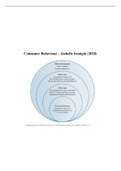Summary
Summary of Chapter 1 and 2 of Consumer Behaviour - Isabelle Szmigin & Maria Piacentini (2018): Historical and Current Perspectives on Consumption
- Course
- Institution
- Book
Summary of Chapter 1 and 2 of Consumer Behaviour - Isabelle Szmigin & Maria Piacentini (2018): Historical and Current Perspectives on Consumption
[Show more]




